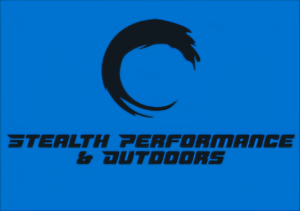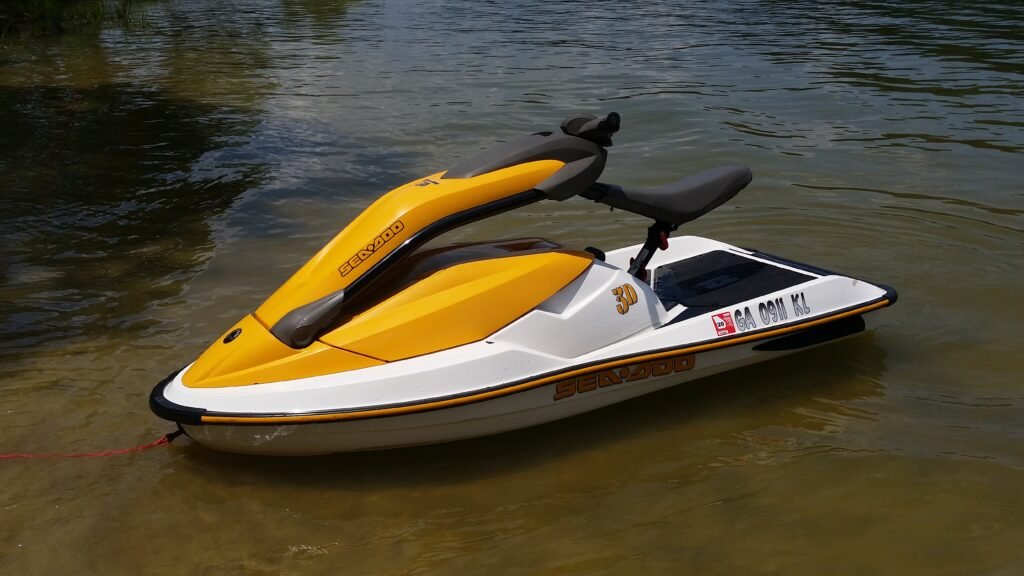This post may contain affiliate links, which means that I may make a small commission off items you purchase at no additional cost to you. Please see my terms of use page for details.
Introduction and History
When Sea-Doo introduced the Sea-Doo 3D in 2004, it wasn’t just another jet ski; it was a game-changer in the world of personal watercraft. This remarkable machine broke the mold of traditional designs with its unique ability to adapt to multiple riding styles, appealing to thrill-seekers and creative riders alike. Dubbed as a hybrid between a stand-up and sit-down jet ski, the Sea-Doo 3D offered unprecedented versatility through its innovative design and optional seating arrangements, such as the “kart seat” and the “moto seat.” Riders could customize their experience, making every ride feel fresh and exciting.
Sea-Doo launched the 3D as part of their effort to attract younger, performance-hungry riders looking for something outside the norm. Produced from 2004 to 2007, the Sea-Doo 3D was built on the hull of the esteemed XP series and offered two engine configurations: the reliable Rotax 787 RFI (110 HP) (2004-2005 models) or the more powerful 947 DI (130 HP)(2006-2007 models). Its compact size, lightweight build, and spirited performance made it a standout on the water, particularly for those who craved agility and speed. The fuel-injected engines not only delivered impressive power but also improved emissions and fuel efficiency, aligning with evolving environmental standards of the time.
The 3D’s revolutionary design created a niche audience who valued creativity, performance, and versatility. Riders could choose from up to five distinctive riding positions, making the 3D a one-of-a-kind offering in the personal watercraft market. Whether kneeling, sitting in a go-kart style, or adopting a dirt-bike-like stance, this jet ski provided a unique and adrenaline-pumping experience. Despite its brilliance, the Sea-Doo 3D faced challenges that ultimately led to its discontinuation, including limited stability in rough waters and a design that catered more to enthusiasts than casual riders. Nevertheless, it remains one of the most innovative personal watercraft models in Sea-Doo’s history, a true testament to the brand’s commitment to pushing boundaries.
The Birth Of The Sea-Doo 3D: Concept and Development
Crafted by a dedicated team of stand-up PWC enthusiasts at Sea-Doo’s R&D development center in Florida, the Sea-Doo 3D emerged as a response to the evolving PWC market. As the industry trended towards larger, less maneuverable 3-seater skis, there arose a gap for a more playful and agile watercraft, especially appealing to younger thrill-seeking riders. Originally conceived as a side project named “Barracuda,” the prototype was pieced together from various Sea-Doo parts, incorporating custom-made elements. Its success in initial trials led to the formal approval of the project by Sea-Doo’s management, ushering in the official development of the Sea-Doo 3D.
Understanding the Sea-doo 3D’s Purpose
Designed primarily for an exciting and fun-filled solo ride, the Sea-doo 3D is not intended for accommodating multiple passengers or carrying substantial gear. Its versatility lies in its ability to offer various riding positions for a sole rider’s enjoyment rather than catering to storage or multi-rider needs. As you can see below; the storage area was very small; maybe enough room for a small drink, DESS key, and registration info.
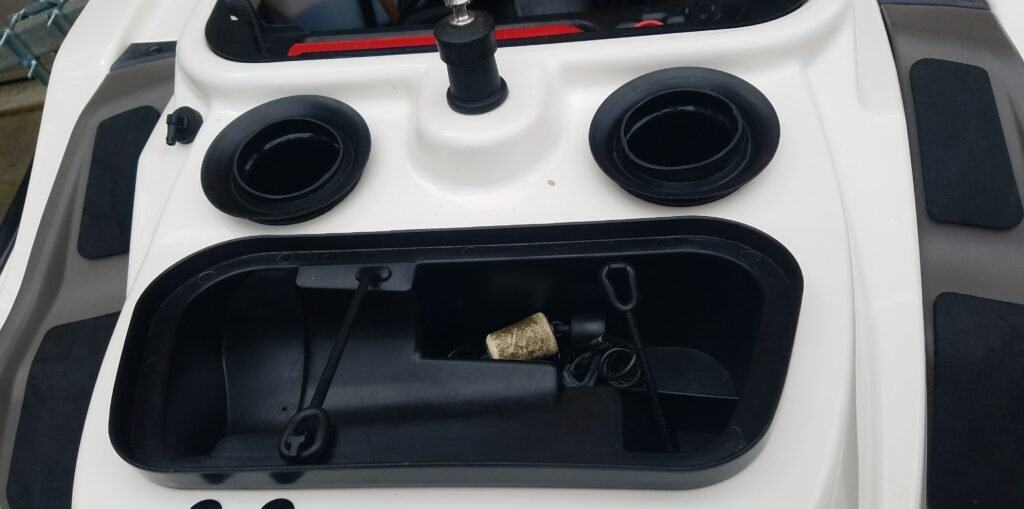
The Sea-doo 3D stands as a remarkable choice for individuals seeking an adrenaline-pumping and personalized jet ski experience, focusing solely on the thrill of riding and maneuvering through the water in diverse styles. Its compact design and emphasis on individual riding dynamics make it an ideal choice for those passionate about personal watercraft performance and excitement.
Another cool feature available for the Seadoo 3D was the manual knob activated trim nozzle, as you can see in the picture below. It may not have been as easy to adjust as the electric button operated or the manual remote cable operated style on prior models but it was dependable, because it had minimal mechanical parts.
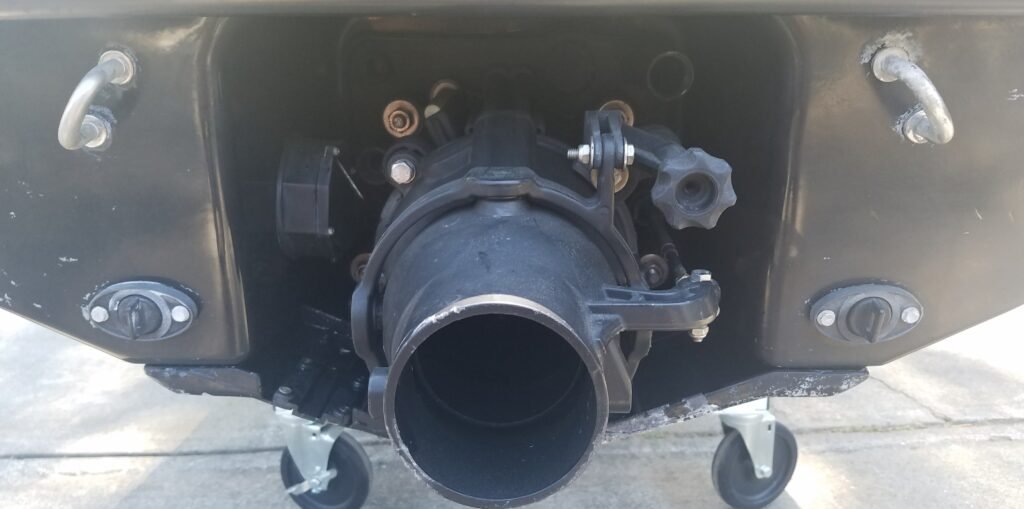
Engine Details: 2004-2005 Sea-doo 3D Power Plant: The 787 RFI Engine
The Sea-Doo 3D is powered by the legendary Rotax 787 RFI engine, a defining feature that helped cement this jet ski’s reputation for performance and innovation. This 782cc, two-stroke, fuel-injected engine was a workhorse of the early 2000s, delivering reliable performance and an impressive power-to-weight ratio. With an output of approximately 110 horsepower, the 787 RFI provided more than enough power for the compact and lightweight Sea-Doo 3D, ensuring spirited acceleration and exhilarating rides.
The Rotax 787 RFI engine was originally featured in many of Sea-Doo’s high-performance models from the late ’90s to the early 2000s. Its RFI (Rotax Fuel Injection) system marked a pivotal moment in personal watercraft technology, offering cleaner emissions, improved fuel efficiency, and superior throttle response compared to carbureted engines of the time. These advancements made it a popular choice among enthusiasts who valued both performance and environmental considerations.
Sea-Doo’s 787 RFI engine was also celebrated for its low-maintenance design and dependable operation, making it a favorite among recreational riders and performance enthusiasts alike. As a 2-stroke, 2-cylinder powerhouse, it represented a shift towards enhanced reliability during a critical era of fuel-injected engine development at Sea-Doo. Even today, many Rotax 787 engines remain in operation, a testament to their durability and engineering excellence.
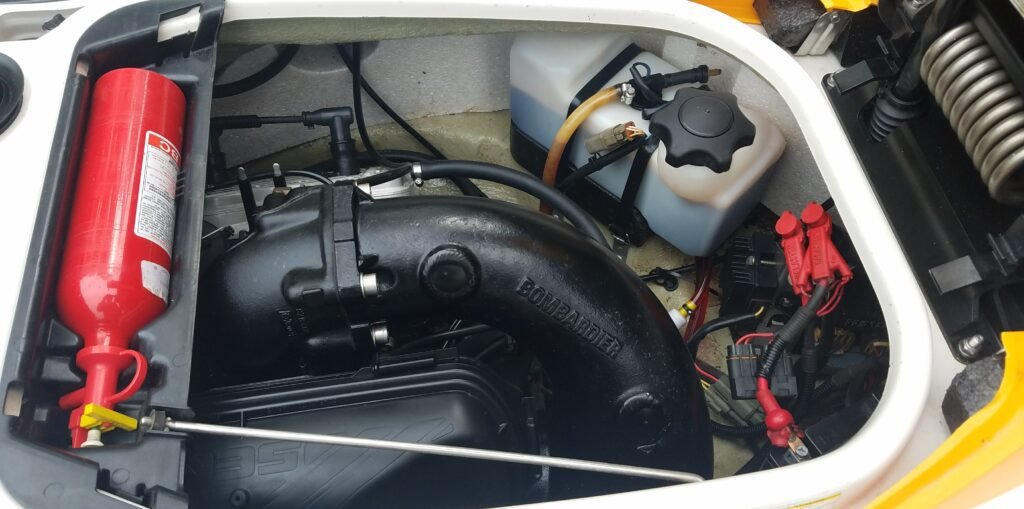
Key Components of the 787 RFI Engine
At its core, the 787 RFI engine integrated the Rave (Rotax Adjustable Variable Exhaust) valves, dynamically managing exhaust port timing to optimize engine efficiency and power output. Moreover, the Rotary Valve, crucial in Seadoo 2-stroke engines, meticulously regulated the air-fuel mixture intake into the cylinders, ensuring precision in fuel delivery and combustion. The engine boasted a sophisticated fuel injection system, delivering exact amounts of fuel into the cylinders for improved throttle response and overall performance.
Performance and Efficiency
Recognized for its spirited performance and efficiency, the 787 RFI engine, with a displacement of 782cc, provided ample power for various Sea-Doo watercraft models. Balancing power and fuel economy, it enabled riders to experience thrilling speeds while maintaining optimal fuel consumption. Technological advancements in the engine, including Rave Valves, Rotary Valve, and the fuel injection system, not only enhanced performance but also reduced emissions, aligning with stringent environmental regulations. This blend of reliability, power, and environmental consciousness solidified the engine’s significance in Sea-Doo’s innovative lineup.
Evolution of the Sea-Doo 3D to the Rotax 947 DI Engine
Initially powered by the Rotax 787 RFI engine, the Sea-Doo 3D’s performance was perceived as lackluster, producing 110 HP and reaching a top speed of 52-54 mph. However, in 2006, the model underwent an upgrade to the more robust 130 HP Rotax 947 DI engine. This enhancement pushed the craft’s top speed to 62 mph, but also resulting in a slightly heavier watercraft.
Primary Specifications and Equipment
The Versatile Sea-doo 3D: Exploring The 5 Different Innovative Riding Positions
The Sea-doo 3D from 2004-2007 stood out in the personal watercraft world for its adaptability, offering riders five distinct riding positions, catering to various preferences and riding experiences. Each configuration provided a unique way to enjoy the water, making the Sea-doo 3D a versatile choice for water enthusiasts. Riders could purchase optional seats to change how they interacted with the jet ski, let’s go through each riding position and why it made the Sea-Doo 3D so unique:
VERT Position
The Sea-Doo 3D was a versatile watercraft that catered to various riding styles, among which the VERT configuration stood out. This setup mirrored the conventional stand-up personal watercraft (PWC), providing a unique yet familiar experience for riders. Thanks to its sit-down hull design, standing on the rear flat area while operating the ski became a breeze, granting maneuverability even when stationary. Its outstanding stability made it particularly appealing to beginners and larger riders, facilitating easy navigation through no-wake zones.
Embracing the stand-up style, the Sea-Doo 3D VERT position boasted a notably larger foot pad area than its predecessors in the stand-up jet ski category. This extended platform delivered heightened stability and enhanced control, catering to those seeking a well-balanced stand-up adventure on the water.
Equipped with a fully movable handle pole complete with safety features like an engine kill switch with safety lanyard and thumb-style throttle trigger, riders enjoyed seamless maneuvering, ensuring precise control and responsive handling. The handle pole also housed a multi-function meter, offering valuable indicators such as a low level oil warning light and diagnostic warning light. Premium models even included a 3-bar fuel gauge, adding both convenience and an extra layer of safety to the riding experience.
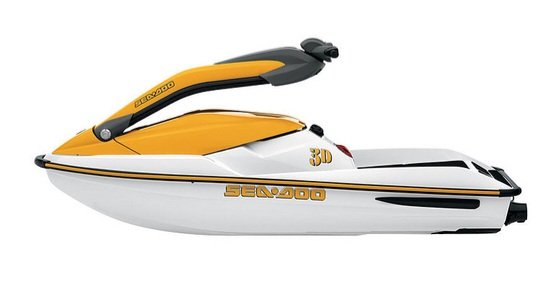
SHOQ Position
In the SHOQ setup, a locked handle pole enhanced stability and control, reducing rider fatigue. This configuration featured a special shock absorber between the top deck and the handle pole, delivering a more comfortable stand-up experience. For most traditional standup jetski riders the VERT position was preferred over the SHOQ position.
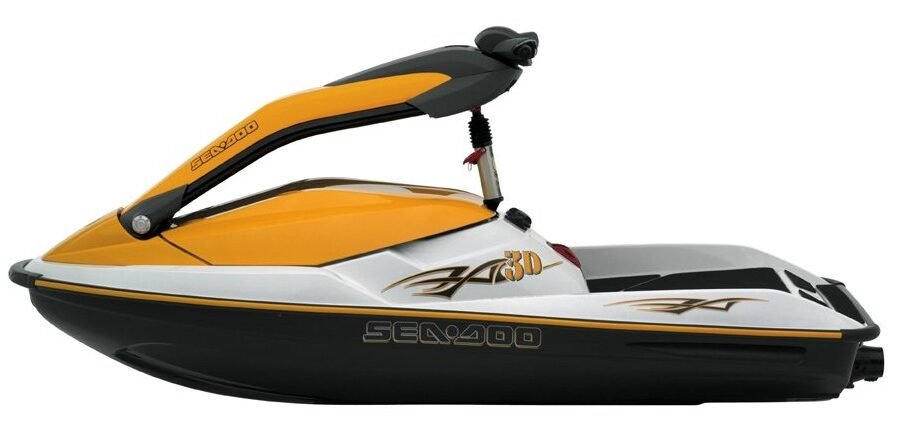
KNEELING Position
Allowing riders to operate the 3D from a kneeling position, the low center of gravity provided a kneeboard-like experience, adding diversity to the riding options. This riding position was considered to be most comparable to riding on a kneeboard being pulled by a rope and handle off the back of a boat.
MOTO SEAT Position
The MOTO position on the Sea-Doo 3D brought forth a distinctive feature by incorporating a seat reminiscent of a dirt-bike seat positioned above the rear deck, resembling the setup seen in the sit-down Sea-Doo XP models. However, despite its innovative design, the discomfort associated with this unique rather tough cushion seat and its proximity to the handlebars stood out as notable drawbacks of this configuration.
A standout element of the Sea-Doo 3D’s uniqueness was the inclusion of a concealed banana seat cleverly tucked away within the handle pole. This MOTO seat could be easily flipped out and secured into a fixed socket located just above the rear deck of the watercraft’s hull. This transition allowed riders to adopt an upright seated riding style, comparable to a more traditional seated experience.
This configuration catered to riders seeking stability and control while navigating through the water, offering an alternative riding position that departed from the standard stand-up or conventional sit-down styles typically associated with personal watercraft.
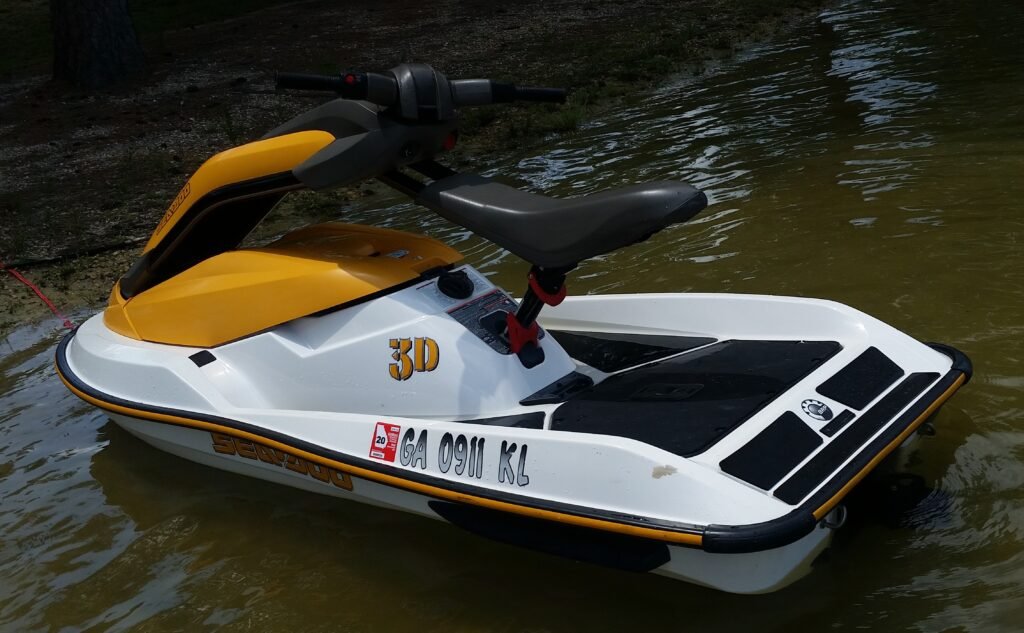
KART SEAT Position
The Kart style position on the Sea-Doo 3D was a remarkable feature that transformed the watercraft into a go-kart-like experience by introducing an optional bucket seat. This unique setup offered riders a radically different yet enjoyable way to navigate the waters. However, it was recommended primarily for calmer waters due to potential discomfort in the lower back when encountering rough conditions.
A highlight of the Sea-Doo 3D was its adaptation for Kart-style riding, achieved through the incorporation of a removable lock-in bucket seat. This seat was ingeniously designed to securely latch onto the standing floor using a lever-style mechanism and had optional removable footrests, catering to riders of varying heights and preferences. With its reclined sitting posture, this configuration provided a relaxed and comfortable experience, ideal for leisurely cruises or casual rides along the waterways.
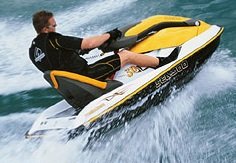
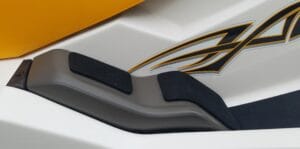
Hull Material and Design
The hull of the Sea-Doo 3D is constructed from fiberglass-reinforced composite, a material Sea-Doo utilized to balance strength and weight. This decision allowed the Sea-Doo 3D to remain light (weighing around 500 lbs) while still being durable enough for recreational use.
The hull design is compact and agile, perfect for flat water conditions where riders can truly exploit its nimble handling. However, in choppy waters, the lightweight hull can bounce and become a challenge to control, making it less suitable for rough conditions.
Professional riders and enthusiasts agree that the Sea-Doo 3D hull was built for performance over comfort, emphasizing quick turns, acceleration, and fun-factor above all else.
What Riders are Saying about the Sea-Doo 3D
Riders have mixed but enthusiastic reviews about the Sea-Doo 3D. For those who love innovation and challenges, it’s a perfect jet ski.
Positive Reviews:
- Unique Riding Experience: The ability to switch between kneeling, kart, and moto seats creates a one-of-a-kind ride.
- Lightweight and Nimble: Riders appreciate its quick acceleration and maneuverability on flat water.
- Fun Factor: Many describe it as a cross between a stand-up jet ski and a motorcycle, offering an adrenaline-pumping experience.
Negative Reviews:
- Stability Issues: The compact size and lightweight design can make the Sea-Doo 3D less stable for beginners.
- Not for Choppy Water: Riders mention that the hull struggles in rough or choppy conditions.
- Limited Storage and Seating Capacity: It’s not ideal for long rides or family use.
Best Accessories Available for the Sea-Doo 3D
- Kart Seat and Moto Seat: Essential for those who want to experience the full versatility of the Sea-Doo 3D.
- Custom Traction Mats: Enhance grip and comfort, especially for kneeling riders.
- Performance Impeller: Upgrade the jet pump for better acceleration and top speed.
- Aftermarket Exhaust Systems: Improve throttle response and add a sporty exhaust note.
- Storage Covers: Protect your Sea-Doo 3D from the elements.
- Oil Injection Block-Off Kit: Popular among performance enthusiasts looking to premix fuel.
Engine Specifications Table
| Feature | 2004-2005 Sea-Doo 3D RFI Details |
|---|---|
| Engine Type | Rotax 787 RFI 2-Stroke |
| Horsepower (hp) | 110 hp |
| Top Speed (mph) | 52-54 mph |
| Displacement (cc) | 782 cc |
| Cylinder Bore & Stroke (mm) | 82 mm x 74 mm |
| Compression Ratio | 6.0: 1 |
| # of Cylinders | 2 |
| Cooling System | Water-Cooled |
| Fuel System Type | Rotax Fuel Injection |
| Fuel Minimum Octane Rating | 87 |
| Fuel Consumption | ~6-8 gallons/hour |
| Oil Capacity (gal/ quarts) | 1 U.S. gal/ 4 quarts |
| Oil Quantity Needed For Oil Change (gal/ quarts) | 1.3 U.S. gal/ 5.2 quarts |
| Lubrication System | Oil Injection |
| Ignition | Digital Inductive |
| Exhaust | Water-Cooled & Injected |
Engine Specifications Table
| Feature | 2006-2007 Sea-Doo 3D 950 Di Details |
|---|---|
| Engine Type | Rotax 950 Di, 2 Stroke |
| Horsepower (hp) | 130 hp |
| Top Speed (mph) | 62 mph |
| Displacement (cc) | 951 cc |
| Cylinder Bore & Stroke (mm) | 88 mm x 78.2 mm |
| Compression Ratio | 6.0: 1 |
| # of Cylinders | 2 |
| Cooling System | Water-Cooled, Total Loss Type |
| Fuel System Type | Orbital Direct Fuel Injection, Twin Throttle Body (46mm) |
| Fuel Minimum Octane Rating | 87 |
| Fuel Consumption | ~ 3-4 gallons/hour |
| Oil Capacity (gal/ quarts) | 1 U.S. gal/ 4 quarts |
| Oil Quantity Needed For Oil Change (gal/ quarts) | 1.3 U.S. gal/ 5.2 quarts |
| Lubrication System | Oil Injection |
| Ignition | Digital Inductive |
| Exhaust | Water-Cooled & Injected |
2004-2005 Sea-Doo 3D RFI Primary Specifications Table
| Feature | Details |
|---|---|
| Length (“) | 107 inches |
| Width (“) | 44 inches |
Height (“)(VERT) Height (“)(MOTO) Height (“)(KART) | 36.5 inches 44.3 inches 37.8 inches |
Dry Weight (lbs)(VERT) Dry Weight (lbs)(MOTO) Dry Weight (lbs)(KART) | 565 lbs 585 lbs 600 lbs |
| Load Capacity (lbs)(Passenger + Cargo) | 250 lbs |
| Seating Capacity | 1 person |
| Storage Capacity (gal/ liters) | 1.42 gal/5.4 liters |
| Fuel Tank Size/ Capacity (gal/ liters) | 9.2 gal/ 35 liters |
| Fuel Reserve Size/ Capacity (gal/ liters) | 1.3 gal/ 5 liters |
| Battery Size/ Number | 12V 19Ah/ ETX16L |
| Towing Capable (Y/N) | No |
| Hull Material | (FRC) Fiberglasss Reinforced Composite |
| Hull Type | V-Hull |
| Body/ Deck Material | (FRC) Fiberglasss Reinforced Composite |
| Colors Available | White/ Black/ Yellow, White/ Black/ Red |
| Sponsons | Yes/ Standard |
| Boarding Step | No |
| Instrumentation | Basic Warning Lights/ Check Engine Premium Model: Fuel Gauge |
| Drive System | Bombardier Formula Pump |
| Trim System | Premium Model: Manual Adjuster Built Into Pump |
| Rear View Mirrors (Y/N) | No |
| Original Selling Price (Base) | $6,499 USD |
Sea-Doo 3D Service Item Details and Availability Table
| Product | OEM Part Number | Recommended Link To Buy |
|---|---|---|
| Oil Filter | 275000051 | Check Price and Availability |
| Engine Oil | XP-S Synthetic 2-Stroke Oil/ 779127 | Check Price and Availability |
| Spark Plugs | NGK BR8ES | Check Price and Availability |
| Air Filter | N/A | N/A |
| Fuel Filter | Aftermarket Fuel Pump Filters | Check Price and Availability |
| Battery | 278001756/ ETX16L | Check Price and Availability |
| Jet Pump Oil/ Grease | Klotz Aftermarket Oil | Check Price and Availability |
| Storage Cover | OEM N/A | Check Price and Availability |
| Traction Mats | Aftermarket | Check Price and Availability |

Pros and Cons of the Sea-Doo 3D
Pros
- Unique, innovative design with 3 riding modes.
- Lightweight and agile for spirited riding.
- Rotax 787 engine offers solid performance.
Cons
- Limited stability in choppy water.
- No storage options for long rides.
- Single-rider only limits versatility.
Frequently Asked Questions about the Sea-Doo 3D(FAQ’s)
What is the Top Speed of the Sea-Doo 3D? The top speed ranges between 50-55 mph.
Is the Sea-Doo 3D suitable for beginners? It’s better suited for experienced riders due to its lightweight, less-stable design.
What safety features does the Sea-Doo 3D have? The 3D includes a lanyard safety shut-off system.
How is the fuel efficiency of the Sea-Doo 3D? The Rotax 787 RFI engine offers reasonable efficiency for a two-stroke engine.
- Can the Sea-Doo 3D be used for towing activities? No, it’s not suitable for towing.
Challenges and Discontinuation
Despite its innovative design, the Sea-Doo 3D faced several issues that hindered its popularity and led to its discontinuation. Notably, its “Jack of all trades, master of none” identity left it heavier and bulkier than traditional stand-up models, affecting handling and maneuverability.
Additionally, engine reliability became a significant concern, with the 787 RFI and 947 DI engines facing durability and overheating issues, compounded by the craft’s design flaws, including an uneven weight distribution and an imbalanced hull. Ultimately, these challenges marred the Sea-Doo 3D’s reputation, contributing to its demise after a brief three-year production run.
Competition Comparison
When comparing the 2004-2007 Sea-Doo 3D to its closest competitors, the Yamaha SuperJet and Kawasaki SX-R, the differences in design and performance stand out clearly. The Yamaha SuperJet, a pure stand-up jet ski, focuses on agility and simplicity, making it a favorite among racers and seasoned riders. Its lightweight build and responsive handling cater to those who prefer sharp maneuvers and challenging water conditions. On the other hand, the Kawasaki SX-R is a powerhouse, boasting more raw speed and a larger engine than its peers, appealing to riders who prioritize outright performance over versatility.
What sets the Sea-Doo 3D apart is its adaptability, offering five distinct riding modes that transform the experience based on the rider’s preference. Unlike the SuperJet’s fixed stand-up design or the SX-R’s focus on high-speed thrills, the 3D allows riders to switch between kneeling, standing, and seated positions using attachments like the “kart seat” or “moto seat.” This versatility makes the 3D appealing to a broader audience, including beginners and those seeking a unique ride, whereas the SuperJet and SX-R cater more narrowly to experienced riders or racers.
While the SuperJet and SX-R excel in their specialized niches, the Sea-Doo 3D’s innovative design and practical Rotax 787 RFI engine make it a standout choice for riders seeking a blend of fun, performance, and adaptability. Its focus on creating a multi-functional riding experience ensures that it offers something entirely different from the competition, appealing to those who crave versatility over traditional watercraft performance.
Conclusion
The Sea-Doo 3D encapsulated innovation and versatility, allowing riders to explore multiple riding positions, from seated comfort to thrilling stand-up adventures. Its groundbreaking design catered to a spectrum of preferences, appealing to both beginners and seasoned enthusiasts. Alongside this adaptability, a range of optional accessories like custom traction mats, performance impellers, and personalized graphics enabled riders to tailor their experience to match their skills and tastes.
Despite its commendable features, the Sea-Doo 3D faced challenges that curtailed its widespread success. Issues with the craft’s design, including an uneven weight distribution and performance concerns with its engines, hindered its reputation. These setbacks, compounded by its hybrid nature that didn’t fit neatly into either stand-up or sit-down categories, led to the 3D being seen as a “Jack of all trades, master of none” in the PWC market.
Nevertheless, the Sea-Doo 3D remains a testament to Sea-Doo’s commitment to innovation. Its introduction brought a new dimension to personal watercraft, offering unparalleled versatility and diverse riding experiences. Despite its flaws, this unique model left an indelible mark in Sea-Doo’s history, showcasing the brand’s willingness to push boundaries and explore new possibilities in the ever-evolving PWC industry. While it may not have attained widespread popularity, the Sea-Doo 3D stands as a testament to the pursuit of innovation and experimentation in watercraft design.
Disclosure: As an Amazon Associate, I earn from qualifying purchases.
Related Articles:
The Legendary 1996 Seadoo XP Specs And Review
2021 Yamaha Super Jet Specs And Review: A Revamped Stand-Up PWC for a New Generation
